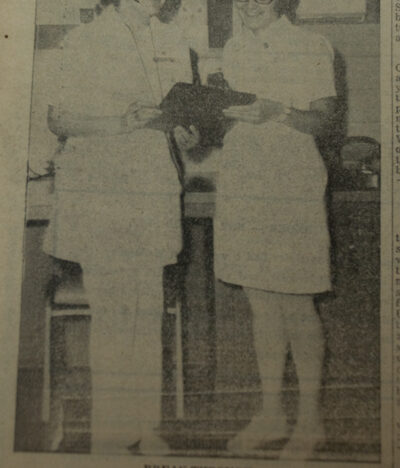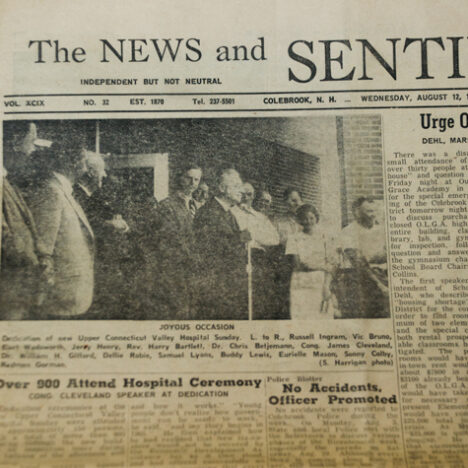How it all began . . .
Back in the early 1900’s, there were no official hospitals in Colebrook. References cite that occasionally, surgery was performed in the homes of people, most likely on their kitchen table or parlors.  In 1907, a house on Pleasant Street was established as the White Mountain Health Center until it was discontinued in 1915. On Main Street in the early 1920s, a Doctor Jones established a hospital which was later replaced by a different hospital in what is now the Creative Natives store. This hospital experienced an expansion in its lifetime, but when the founding father, Dr. Ker died, the Bank took it over and it later became a tavern. In 1932, the present day Coos County Nursing Hospital was built. The third floor was set aside as a hospital for the general public, while the rest of the building was devoted to its original design as an almshouse. In 1965, the Coos County Hospital was declared obsolete. That same year, the Upper Connecticut Valley Hospital Association formed as a nonprofit organization. Towns that comprised the organization were Canaan, Lemington, Bloomfield and Brunswick, Vermont, Stewartstown, Clarksville, Colebrook, Columbia, Stratford and Errol, NH. Wilson Mills was the only town represented from the state of Maine. Through efforts of the organization, a Federal Grant from both the Economic Development Administration and the New England Regional Commission was obtained and provided 80% of the funds to construct a new $1,414,000.00 hospital in Colebrook.
In 1907, a house on Pleasant Street was established as the White Mountain Health Center until it was discontinued in 1915. On Main Street in the early 1920s, a Doctor Jones established a hospital which was later replaced by a different hospital in what is now the Creative Natives store. This hospital experienced an expansion in its lifetime, but when the founding father, Dr. Ker died, the Bank took it over and it later became a tavern. In 1932, the present day Coos County Nursing Hospital was built. The third floor was set aside as a hospital for the general public, while the rest of the building was devoted to its original design as an almshouse. In 1965, the Coos County Hospital was declared obsolete. That same year, the Upper Connecticut Valley Hospital Association formed as a nonprofit organization. Towns that comprised the organization were Canaan, Lemington, Bloomfield and Brunswick, Vermont, Stewartstown, Clarksville, Colebrook, Columbia, Stratford and Errol, NH. Wilson Mills was the only town represented from the state of Maine. Through efforts of the organization, a Federal Grant from both the Economic Development Administration and the New England Regional Commission was obtained and provided 80% of the funds to construct a new $1,414,000.00 hospital in Colebrook.
In August of 1970, the hospital opened as a 30-bed facility in the town of Colebrook, NH at the site of the old fairgrounds. History on the fairgrounds, to summarize, was that the land was devoted in 1876 to the formation of a trotting park. The trotting park incorporated a track one-half mile in length, 24 feet in width except for the homestretch, which was expanded to 35 feet across. The opening of the park proved to be a successful venture for the Riding Park Association, who delighted in the fact that on opening day, passenger trains were bringing 1000 people in on each trip. By noontime that day, there were 4000 people on the grounds! Gambling on the horse-races continued for several years until the park became the center for the Coos and Essex Fair. The Fair later moved to Lancaster, NH, and with this move, so went the trotting horses. A dedication ceremony for the new hospital was held on August 9, 1970, with over 900 people attending. Congressman James C. Cleveland was cited by the then President of the Upper Connecticut Valley Hospital Association, Dr. William H. Gifford, as “the man who raised hell in Washington and got us our hospital.”
 The new hospital was designed at the time, to provide complete family-centered inpatient and outpatient care for the North East Kingdom. The hospital provided a continuum of services such as Obstetrics, Medical and Surgical Care, an Emergency Room, doctor’s offices, ancillary services, etc. In 1983, the hospital expanded and built the Marjorie A. Parsons wing which allowed for the separation of administrative and clinical space as well as to provide additional square footage for services.
The new hospital was designed at the time, to provide complete family-centered inpatient and outpatient care for the North East Kingdom. The hospital provided a continuum of services such as Obstetrics, Medical and Surgical Care, an Emergency Room, doctor’s offices, ancillary services, etc. In 1983, the hospital expanded and built the Marjorie A. Parsons wing which allowed for the separation of administrative and clinical space as well as to provide additional square footage for services.
Dr. William H. Gifford was born in Concord, NH on May 5, 1914, the son of William James and Ellen (Smith) Gifford. He was a graduate of Concord High School in 1932 and U.N.H. in 1935. In 1940, he received his M.D. from McGill University. He served as an intern at St. Luke’s Hospital in New Bedford, Massachusetts, in 1940-41. In 1941 he entered the Armed Services, from which he was discharged with the rank of Lt. Col. M.C. in 1946. In that year he began his practice in Colebrook, where he entered into numerous community activities with his wife, Dr. Marjorie Parsons. Dr. Gifford was active in the establishment of the Upper Connecticut Valley Hospital and is considered to be the founding father. He represented his community and profession at both the state and national level. He retired in 1989. He passed away on March 31, 1997. Presiding over the Nurses Station, an etched portrait of Dr. Gifford hangs with the inscription that he was “a man of magic, medicine, and miracles.” Indeed, every day at Upper Connecticut Valley Hospital, magic, medicine, and miracles happen through the work of passionate, dedicated staff members who will never forget how it all began.

